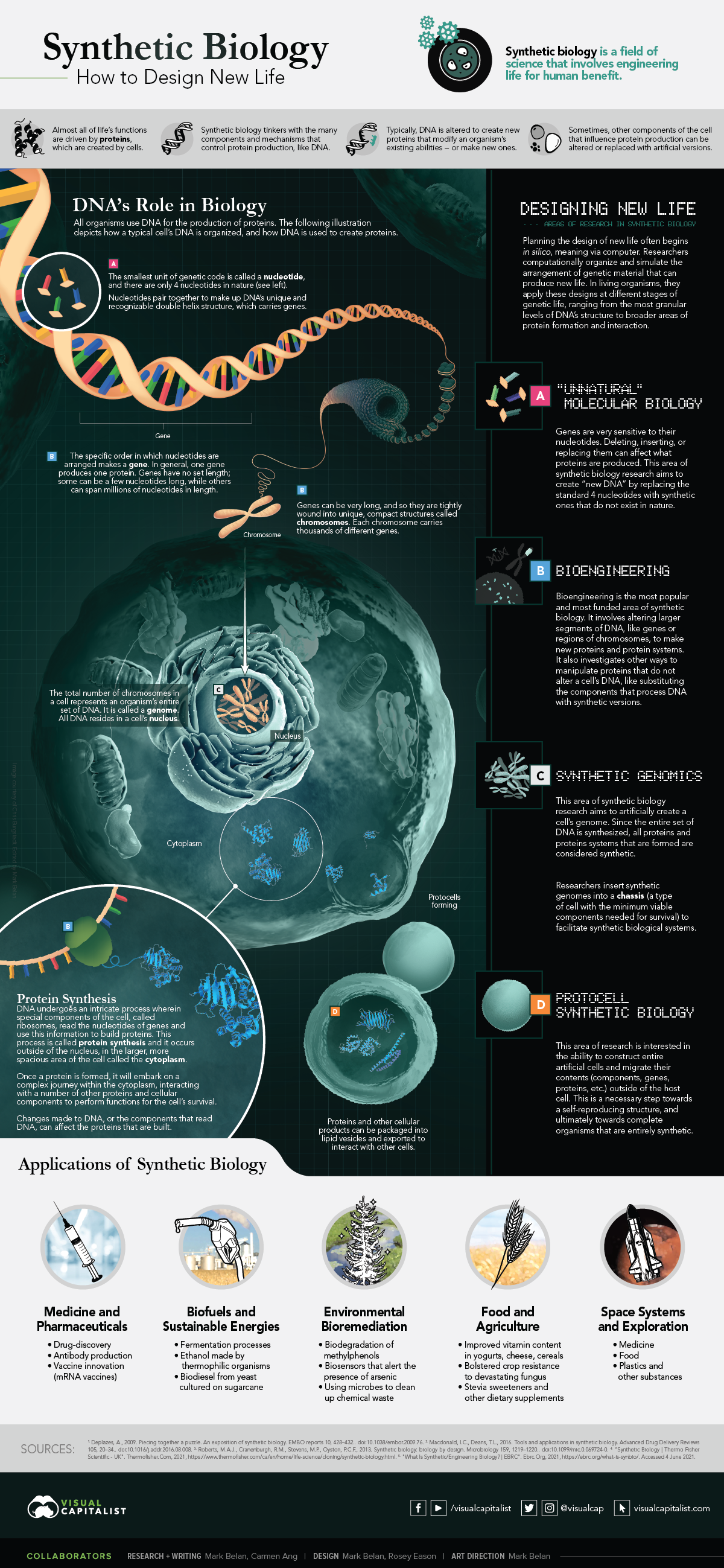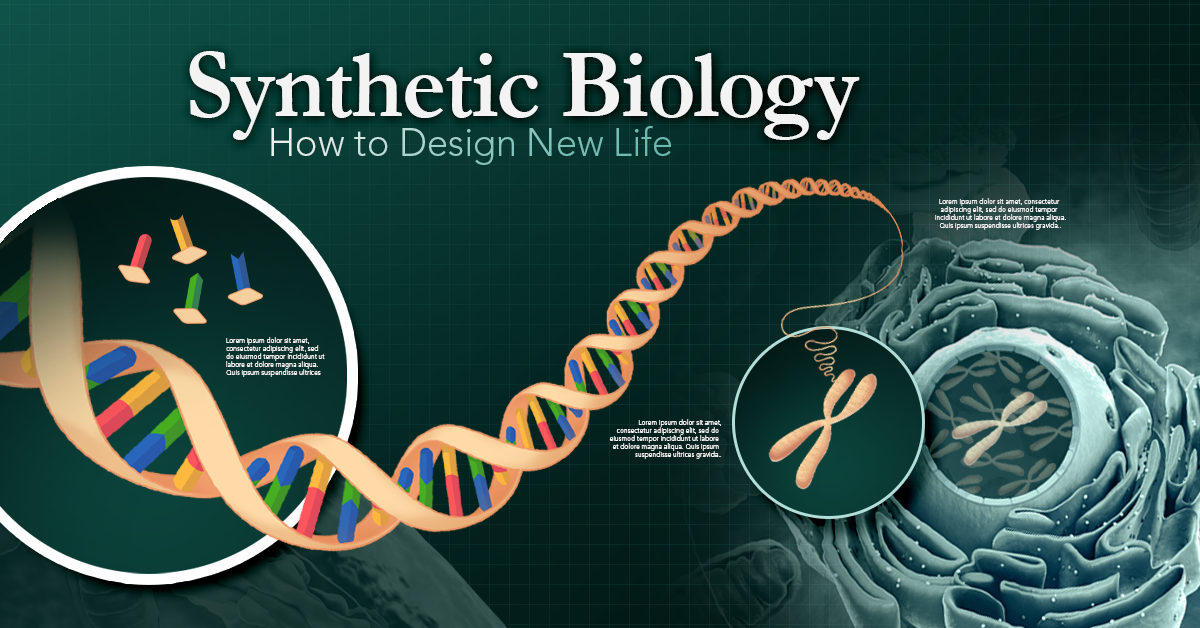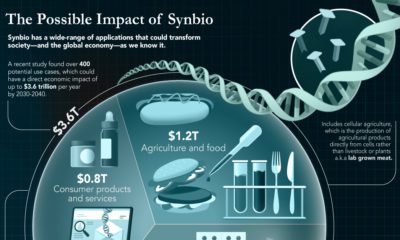Technology
Explainer: How Synthetic Biology is Redesigning Life

Explainer: How Synthetic Biology is Redesigning Life
Synthetic biology (SynBio) is a field of science that involves engineering life for human benefit. It has the potential to reshape many facets of society—from the ways we produce food, to how we detect and cure diseases.
It’s a fast-growing field of science. In fact, by 2026, the SynBio market’s global revenue is expected to reach $34.5 billion, at a CAGR of 21.9%.
While this fascinating area of research is worth paying attention to, it might be daunting to wrap your head around—especially if you don’t come from a scientific background. With this in mind, here’s an introduction to synthetic biology, and how it works.
What is Synthetic Biology?
As we touched on in the introduction, SynBio is an area of scientific research that involves editing and redesigning the biological components, systems, and interactions that make up life. By doing this, SynBio can grant organisms new abilities that are beneficial to humans.
It’s similar to genetic engineering, however, it’s slightly more granular. While genetic engineering transfers ready-made genetic material between organisms, SynBio builds new genetic material from scratch.
SynBio has applications across a myriad of fields, with research covering everything from space exploration to drug discovery. Here’s a look at five of its real-world applications:
1. Medical Technologies
SynBio has a wide range of medical applications, including drug discovery, antibody production, and vaccine innovation (it’s been key in the fight against COVID-19). It also plays a significant role in “living drug” development, which is the use of living microbes to treat chronic or severe illnesses.
2. Sustainable Energies
Biofuel, which is renewable energy that’s derived from living matter, could replace petroleum and diesel in the near future—and synthetic biology technology is helping develop fermentation processes that will produce biofuel more efficiently.
3. Bioremediation
Bioremediation uses living organisms to restore polluted sites to their original condition. This field uses SynBio to try and make the decontamination process more efficient, and to expand the list of contaminants that bioremediation can target.
4. Food and Agriculture
SynBio plays a significant role in cellular agriculture, which is the production of agricultural products directly from cells rather than livestock or plants. These modified foods might have higher nutritional value, or might be void of allergens. For instance, this can be used to make plant-based burgers taste more like meat.
5. Space Systems and Exploration
Synthetic biology and 3-D printing have huge potential to sustain life during space exploration. Using SynBio technology, cells and bacteria could be modified to produce a myriad of materials—from plastic to medicine, and even food—and astronauts could print these synthetically engineered materials on-demand while in space.
Zooming in: the Science Behind Synthetic Biology
Now that we’ve touched on SynBio’s use in a wide range of industries, let’s dive into the science behind it. In order to understand the mechanics of SynBio, it’s important to explore the relationship between DNA and protein production.
Proteins are the drivers of life in a cell—they’re responsible for carrying out all of life’s functions. They are created through a process called protein synthesis, which relies heavily on DNA. Why is DNA so important in protein production? Because it houses all the information a cell needs for protein synthesis.
Once a protein is formed, it embarks on a complex journey throughout the cell, interacting with a number of other proteins and cellular components to perform functions needed for the cell’s survival.
This process of protein production and cellular interaction is an example of a biological system. And it’s this biological system that synthetic biologists investigate, and try to manipulate.
The Five Main Areas of Research
After combing through the literature, we identified five major areas of SynBio research:
- In silico Synthetic Biology
Meaning “via computer”, this area of SynBio research uses computational simulations to design and predict new biological systems. It’s like using a drawing board before starting a project. - “Unnatural” Molecular Biology
An area of research focused on altering the smallest unit of DNA—nucleotides. - Bioengineering
This area of research deals with larger segments of DNA like genes or chromosomes, and sometimes other cell components that interact with DNA. It aims to create new proteins or protein systems and is the most popular area of SynBio research. - Synthetic Genomics
Focused on altering and manipulating whole genomes (which is the complete set of a cell’s DNA). - Protocell Synthetic Biology
This field of research aims to construct whole cells. This is a step towards creating organisms that are entirely synthetic
While early research in SynBio struggled to finish real-world projects, innovation in this field has ramped up quickly in the last decade.
Synthetic biology products are becoming increasingly more pervasive in everyday life—so much so that by 2030, some scientists believe most people will have eaten, worn, or used something created through synthetic biology.
Technology
Charting the Next Generation of Internet
In this graphic, Visual Capitalist has partnered with MSCI to explore the potential of satellite internet as the next generation of internet innovation.

Could Tomorrow’s Internet be Streamed from Space?
In 2023, 2.6 billion people could not access the internet. Today, companies worldwide are looking to innovative technology to ensure more people are online at the speed of today’s technology.
Could satellite internet provide the solution?
In collaboration with MSCI, we embarked on a journey to explore whether tomorrow’s internet could be streamed from space.
Satellite Internet’s Potential Customer Base
Millions of people live in rural communities or mobile homes, and many spend much of their lives at sea or have no fixed abode. So, they cannot access the internet simply because the technology is unavailable.
Satellite internet gives these communities access to the internet without requiring a fixed location. Consequently, the volume of people who could get online using satellite internet is significant:
| Area | Potential Subscribers |
|---|---|
| Households Without Internet Access | 600,000,000 |
| RVs | 11,000,000 |
| Recreational Boats | 8,500,000 |
| Ships | 100,000 |
| Commercial Aircraft | 25,000 |
Advances in Satellite Technology
Satellite internet is not a new concept. However, it has only recently been that roadblocks around cost and long turnaround times have been overcome.
NASA’s space shuttle, until it was retired in 2011, was the only reusable means of transporting crew and cargo into orbit. It cost over $1.5 billion and took an average of 252 days to launch and refurbish.
In stark contrast, SpaceX’s Falcon 9 can now launch objects into orbit and maintain them at a fraction of the time and cost, less than 1% of the space shuttle’s cost.
| Average Rocket Turnaround Time | Average Launch/Refurbishment Cost | |
|---|---|---|
| Falcon 9* | 21 days | < $1,000,000 |
| Space Shuttle | 252 days | $1,500,000,000 (approximately) |
Satellites are now deployed 300 miles in low Earth orbit (LEO) rather than 22,000 miles above Earth in Geostationary Orbit (GEO), previously the typical satellite deployment altitude.
What this means for the consumer is that satellite internet streamed from LEO has a latency of 40 ms, which is an optimal internet connection. Especially when compared to the 700 ms stream latency experienced with satellite internet streamed from GEO.
What Would it Take to Build a Satellite Internet?
SpaceX, the private company that operates Starlink, currently has 4,500 satellites. However, the company believes it will require 10 times this number to provide comprehensive satellite internet coverage.
Charting the number of active satellites reveals that, despite the increasing number of active satellites, many more must be launched to create a comprehensive satellite internet.
| Year | Number of Active Satellites |
|---|---|
| 2022 | 6,905 |
| 2021 | 4,800 |
| 2020 | 3,256 |
| 2019 | 2,272 |
| 2018 | 2,027 |
| 2017 | 1,778 |
| 2016 | 1,462 |
| 2015 | 1,364 |
| 2014 | 1,262 |
| 2013 | 1,187 |
Next-Generation Internet Innovation
Innovation is at the heart of the internet’s next generation, and the MSCI Next Generation Innovation Index exposes investors to companies that can take advantage of potentially disruptive technologies like satellite internet.
You can gain exposure to companies advancing access to the internet with four indexes:
- MSCI ACWI IMI Next Generation Internet Innovation Index
- MSCI World IMI Next Generation Internet Innovation 30 Index
- MSCI China All Shares IMI Next Generation Internet Innovation Index
- MSCI China A Onshore IMI Next Generation Internet Innovation Index
MSCI thematic indexes are objective, rules-based, and regularly updated to focus on specific emerging trends that could evolve.

Click here to explore the MSCI thematic indexes

-

 Technology1 week ago
Technology1 week agoCountries With the Highest Rates of Crypto Ownership
While the U.S. is a major market for cryptocurrencies, two countries surpass it in terms of their rates of crypto ownership.
-

 Technology2 weeks ago
Technology2 weeks agoMapped: The Number of AI Startups By Country
Over the past decade, thousands of AI startups have been funded worldwide. See which countries are leading the charge in this map graphic.
-

 Technology3 weeks ago
Technology3 weeks agoAll of the Grants Given by the U.S. CHIPS Act
Intel, TSMC, and more have received billions in subsidies from the U.S. CHIPS Act in 2024.
-

 Technology3 weeks ago
Technology3 weeks agoVisualizing AI Patents by Country
See which countries have been granted the most AI patents each year, from 2012 to 2022.
-

 Technology4 weeks ago
Technology4 weeks agoHow Tech Logos Have Evolved Over Time
From complete overhauls to more subtle tweaks, these tech logos have had quite a journey. Featuring: Google, Apple, and more.
-

 AI1 month ago
AI1 month agoRanked: Semiconductor Companies by Industry Revenue Share
Nvidia is coming for Intel’s crown. Samsung is losing ground. AI is transforming the space. We break down revenue for semiconductor companies.
-

 Personal Finance1 week ago
Personal Finance1 week agoVisualizing the Tax Burden of Every U.S. State
-

 Misc6 days ago
Misc6 days agoVisualized: Aircraft Carriers by Country
-

 Culture6 days ago
Culture6 days agoHow Popular Snack Brand Logos Have Changed
-

 Mining1 week ago
Mining1 week agoVisualizing Copper Production by Country in 2023
-

 Misc1 week ago
Misc1 week agoCharted: How Americans Feel About Federal Government Agencies
-

 Healthcare1 week ago
Healthcare1 week agoWhich Countries Have the Highest Infant Mortality Rates?
-

 Demographics1 week ago
Demographics1 week agoMapped: U.S. Immigrants by Region
-

 Maps1 week ago
Maps1 week agoMapped: Southeast Asia’s GDP Per Capita, by Country










